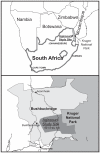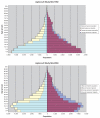Research into health, population and social transitions in rural South Africa: data and methods of the Agincourt Health and Demographic Surveillance System
- PMID: 17676498
- PMCID: PMC2826136
- DOI: 10.1080/14034950701505031
Research into health, population and social transitions in rural South Africa: data and methods of the Agincourt Health and Demographic Surveillance System
Abstract
Rationale for study: Vital registration is generally lacking in infrastructurally weak areas where health and development problems are most pressing. Health and demographic surveillance is a response to the lack of a valid information base that can provide high-quality longitudinal data on population dynamics, health, and social change to inform policy and practice.
Design and measurement procedures: Continuous demographic monitoring of an entire geographically defined population involves a multi-round, prospective community study, with annual recording of all vital events (births, deaths, migrations). Status observations and special modules add value to particular research areas. A verbal autopsy is conducted on every death to determine its probable cause. A geographic surveillance system supports spatial analyses, and strengthens field management.
Population and sample size considerations: Health and demographic surveillance covers the Agincourt sub-district population, sited in rural north-eastern South Africa, of some 70,000 people (nearly a third are Mozambican immigrants) in 21 villages and 11,700 households. Data enumerated are consistent or more detailed when compared with national sources; strategies to improve incomplete data, such as counts of perinatal deaths, have been introduced with positive effect. Basic characteristics: A major health and demographic transition was documented over a 12-year period with marked changes in population structure, escalating mortality, declining fertility, and high levels of temporary migration increasing particularly amongst women. A dual burden of infectious and non-communicable disease exists against a background of dramatically progressing HIV/AIDS.
Potential and research questions: Health and demographic surveillance sites - fundamental to the INDEPTH Network - generate research questions and hypotheses from empirical data, highlight health, social and population priorities, provide cost-effective support for diverse study designs, and track population change and the impact of interventions over time.[image omitted].
Figures



References
-
- Tollman SM. The Agincourt field site: Evolution and current status. S Afr Med J. 1999;89:853–8. - PubMed
-
- Tollman SM, Herbst K, Garenne M, Gear JSS, Kahn K. The Agincourt Demographic and Health Study: Site description, baseline findings and implications. S Afr Med J. 1999;89:858–64. - PubMed
-
- Tollman SM, Herbst K, Garenne M. The Agincourt Demographic and Health Study, Phase 1. Health Systems Development Unit, Department of Community Health, University of the Witwatersrand; Johannesburg: 1995.
-
- Robbins D. Agincourt: A district health demonstration site. Health Systems Trust; Durban: 1997.
-
- Tollman SM, Kahn K. Report on the meeting Strengthening ties: the Agincourt field site in its African context. Trop Med Int Health. 1997;2:920–3.
Publication types
MeSH terms
Grants and funding
LinkOut - more resources
Full Text Sources
Medical
